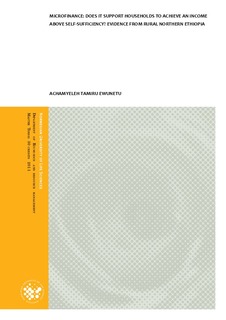| dc.description.abstract | While the expansion of Microfinance
institutions throughout the
third world is clear, the policy
ramifications are not. As in many
countries in Sub-‐Saharan Africa,
program credit impact assessment
has come under much scrutiny
in Ethiopia. However, non-‐classical
measurement error, self selection
into the program, lack of valid
exclusion restrictions, violation
of key ignorability-‐of-‐treatment
assumption coupled
with difficulty of finding
good identification strategy when
conditional independence
fails, complicates the identification
of the causal effects of Microfinance.
In this paper, the researcher
identifies the impact of Microfinance
on income and non-‐income
indicators of poverty in the rural
areas of the Tigray region
of Ethiopia by using two rounds
of regional representative
household survey data
that were collected in 2006,
and more recently in 2010.
In particular, the researcher
studies whether microfinance
credit is reducing poverty,
helps the poorest of the poor
and the amount of malnutrition
reduced because of microfinance
credit. In order to consistently
identify the causal effect of
participation in Microfinance
and compare the results,
the researcher uses two new
estimators called Klein and
Vella (KV) and minimum
biased estimator along
with the standard Heckman
bivariate normal (BVN) selection
model. The researcher
finds consistent evidence of causal
effect of participation in Microfinance
on reducing child malnutrition
and increasing annual per
capita consumption expenditure
when applying the three estimators.
More importantly, the study
has shown that the poorest
of the poor are benefiting
more from Microfinance
credit program than the
moderate poor rural households
in Tigray. Findings also suggest
that around
3%
of
the
reduction
in
the
gap
of
sever
poverty
in
Tigray
is
made
possible
by
program
credit.
Results
show
how
Social
Welfare
programs
aimed
at
poverty
alleviation
among
those
living
in
severe
poverty
can
affect
child
malnutrition
outcomes,
which
goes
beyond
the
standard
poverty
measures
of
consumption
and
income. | no_NO |
